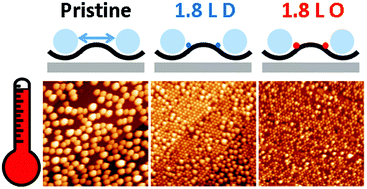Our official English website, www.x-mol.net, welcomes your feedback! (Note: you will need to create a separate account there.)
Preventing sintering of nanoclusters on graphene by radical adsorption
Nanoscale ( IF 6.7 ) Pub Date : 2017-08-29 00:00:00 , DOI: 10.1039/c7nr04491g A. J. Martínez-Galera 1, 2, 3, 4 , U. A. Schröder 1, 2, 3, 4 , C. Herbig 1, 2, 3, 4 , M. A. Arman 5, 6, 7, 8 , J. Knudsen 5, 6, 7, 8, 9 , T. Michely 1, 2, 3, 4
Nanoscale ( IF 6.7 ) Pub Date : 2017-08-29 00:00:00 , DOI: 10.1039/c7nr04491g A. J. Martínez-Galera 1, 2, 3, 4 , U. A. Schröder 1, 2, 3, 4 , C. Herbig 1, 2, 3, 4 , M. A. Arman 5, 6, 7, 8 , J. Knudsen 5, 6, 7, 8, 9 , T. Michely 1, 2, 3, 4
Affiliation

|
Metal nanoclusters, supported on inert substrates, exhibiting well-defined shapes and sizes in a broad range of temperatures are a major object of desire in nanotechnology. Here, a technique is presented that improves the thermal stability of monodisperse and crystalline transition metal nanoclusters grown in a regular array on metal-supported graphene. To stabilize the clusters after growth under ultrahigh vacuum the system composed of the aggregates and the graphene/metal interface is exposed to radicals resulting from the dissociation of diatomic gases. As a model system we have used Pt as the metal element for cluster growth and the template consisting of the moiré pattern resulting from the lattice mismatch between graphene and the Ir(111) surface. The study has been performed for deuterium and oxygen radicals, which interact very differently with graphene. Our results reveal that after radical exposure the thermally activated motion of Pt nanoclusters to adjacent moiré cells and the subsequent sintering of neighbor aggregates are avoided, most pronounced for the case of atomic O. For the case of D the limits of the improvement are given by radical desorption, whereas for the case of O they are defined by an interplay between coalescence and graphene etching followed by Pt intercalation, which can be controlled by the amount of exposure. Finally, we determined the mechanism of how radical adsorption improves the thermal stability of the aggregates.
中文翻译:

通过自由基吸附防止纳米团簇在石墨烯上的烧结
支撑在惰性基底上的金属纳米团簇,在宽广的温度范围内表现出明确的形状和大小,是纳米技术的主要目标。在这里,提出了一种技术,可以改善在金属负载的石墨烯上以规则阵列生长的单分散和晶体过渡金属纳米簇的热稳定性。为了在超高真空下生长后稳定团簇,将由聚集体和石墨烯/金属界面组成的体系暴露于双原子气体解离产生的自由基。作为模型系统,我们使用Pt作为簇生长的金属元素,并使用由莫尔图案组成的模板,该莫尔图案是由石墨烯和Ir(111)表面之间的晶格失配引起的。已经对氘和氧自由基进行了研究,与石墨烯的相互作用非常不同。我们的结果表明,在自由基暴露后,避免了Pt纳米团簇向邻近的莫尔条纹单元的热活化运动以及随后的相邻聚集体的烧结,这在原子O的情况下最为明显。对于D的情况,改进的极限由下式给出:自由基解吸,而对于O而言,它们是由聚结和石墨烯蚀刻以及随后的Pt嵌入之间的相互作用定义的,该相互作用可以通过曝光量来控制。最后,我们确定了自由基吸附如何改善聚集体的热稳定性的机理。对于原子O的情况最明显。对于D的情况,改进的极限由自由基解吸给出,而对于O的情况,其改善是由聚结和石墨烯蚀刻之间的相互作用以及随后的Pt插层定义的。由曝光量控制。最后,我们确定了自由基吸附如何改善聚集体的热稳定性的机理。对于原子O的情况最明显。对于D的情况,改进的极限由自由基解吸给出,而对于O的情况,其改善是由聚结和石墨烯蚀刻之间的相互作用以及随后的Pt插层定义的。由曝光量控制。最后,我们确定了自由基吸附如何改善聚集体的热稳定性的机理。
更新日期:2017-09-21
中文翻译:

通过自由基吸附防止纳米团簇在石墨烯上的烧结
支撑在惰性基底上的金属纳米团簇,在宽广的温度范围内表现出明确的形状和大小,是纳米技术的主要目标。在这里,提出了一种技术,可以改善在金属负载的石墨烯上以规则阵列生长的单分散和晶体过渡金属纳米簇的热稳定性。为了在超高真空下生长后稳定团簇,将由聚集体和石墨烯/金属界面组成的体系暴露于双原子气体解离产生的自由基。作为模型系统,我们使用Pt作为簇生长的金属元素,并使用由莫尔图案组成的模板,该莫尔图案是由石墨烯和Ir(111)表面之间的晶格失配引起的。已经对氘和氧自由基进行了研究,与石墨烯的相互作用非常不同。我们的结果表明,在自由基暴露后,避免了Pt纳米团簇向邻近的莫尔条纹单元的热活化运动以及随后的相邻聚集体的烧结,这在原子O的情况下最为明显。对于D的情况,改进的极限由下式给出:自由基解吸,而对于O而言,它们是由聚结和石墨烯蚀刻以及随后的Pt嵌入之间的相互作用定义的,该相互作用可以通过曝光量来控制。最后,我们确定了自由基吸附如何改善聚集体的热稳定性的机理。对于原子O的情况最明显。对于D的情况,改进的极限由自由基解吸给出,而对于O的情况,其改善是由聚结和石墨烯蚀刻之间的相互作用以及随后的Pt插层定义的。由曝光量控制。最后,我们确定了自由基吸附如何改善聚集体的热稳定性的机理。对于原子O的情况最明显。对于D的情况,改进的极限由自由基解吸给出,而对于O的情况,其改善是由聚结和石墨烯蚀刻之间的相互作用以及随后的Pt插层定义的。由曝光量控制。最后,我们确定了自由基吸附如何改善聚集体的热稳定性的机理。



























 京公网安备 11010802027423号
京公网安备 11010802027423号